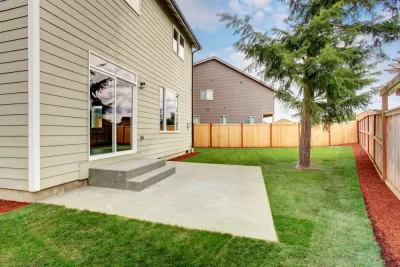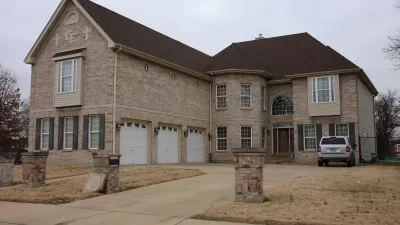Americans have shown a clear preference for larger homes—even at the expense of the coveted backyard.

"The Yard — once the birthright of suburban American families with two kids, a dog, and a station wagon — is more endangered than ever," according to a feature article by Keith O'Brien.
Th article begins with a detailed anecdote about the home of Scott Nguyen, who has repeatedly expanded the square footage of his home, and of the paved surfaces outside it, in Winchester, Massachusetts. Nguyen's neighbors responded to the modifications by appealing to the city's zoning board, which then declared the new yard a "parking lot," and called for its removal. Nguyen has sued the board in Middlesex Superior Court.
After telling that story, O'Brien turns to the trend exemplified by Nguyen's story around the country:
According to US Census data, the size of new American homes has been climbing steadily for the past 15 years — up about 21 percent, to more than 2,500 square feet of indoor living space.
Meanwhile outdoor space has been shrinking:
The typical lot of a new home sold in this country is about 400 square feet smaller today than it was just five years ago.
The article includes details about the municipalities where the battles over teardowns have played out in Massachusetts, as well as the developers making the market-driven decisions affecting the built environment. O'Brien also considers the consequences of these building trends on the residents of the United States.
FULL STORY: The incredible shrinking American yard

Maui's Vacation Rental Debate Turns Ugly
Verbal attacks, misinformation campaigns and fistfights plague a high-stakes debate to convert thousands of vacation rentals into long-term housing.

Planetizen Federal Action Tracker
A weekly monitor of how Trump’s orders and actions are impacting planners and planning in America.

San Francisco Suspends Traffic Calming Amidst Record Deaths
Citing “a challenging fiscal landscape,” the city will cease the program on the heels of 42 traffic deaths, including 24 pedestrians.

Defunct Pittsburgh Power Plant to Become Residential Tower
A decommissioned steam heat plant will be redeveloped into almost 100 affordable housing units.

Trump Prompts Restructuring of Transportation Research Board in “Unprecedented Overreach”
The TRB has eliminated more than half of its committees including those focused on climate, equity, and cities.

Amtrak Rolls Out New Orleans to Alabama “Mardi Gras” Train
The new service will operate morning and evening departures between Mobile and New Orleans.
Urban Design for Planners 1: Software Tools
This six-course series explores essential urban design concepts using open source software and equips planners with the tools they need to participate fully in the urban design process.
Planning for Universal Design
Learn the tools for implementing Universal Design in planning regulations.
Heyer Gruel & Associates PA
JM Goldson LLC
Custer County Colorado
City of Camden Redevelopment Agency
City of Astoria
Transportation Research & Education Center (TREC) at Portland State University
Jefferson Parish Government
Camden Redevelopment Agency
City of Claremont





























